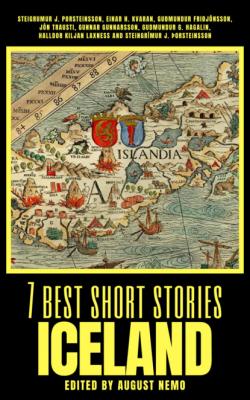ТОП просматриваемых книг сайта:
7 best short stories - Iceland. Steingrímur J. Þorsteinsson
Читать онлайн.Название 7 best short stories - Iceland
Год выпуска 0
isbn 9783968588681
Автор произведения Steingrímur J. Þorsteinsson
Жанр Языкознание
Серия 7 best short stories - specials
Издательство Bookwire
Most Icelandic writers have, of course, written in the vernacular only, in spite of longer or shorter stay abroad. This applies to the last two authors represented here, both of whom appeared on the literary scene about 1920.
Guðmundur G. Hagalín (b. 1898) comes from the sea-girt Western Fiords, where he was a fisherman before attending secondary school. Later, he lectured on Iceland in Norway for a few years (1924-27), and is now a superintendent of public libraries. His home is in the neighbourhood of Reykjavík. In his novels, and more particularly in his short stories, he is at his best in his portrayals of the simple sturdy seamen and countryfolk of his native region, which are often refreshingly arch in manner. Hagalín, who is a talented narrator, frequently succeeds in catching the living speech and characteristic mode of expression of his characters. The Fox Skin (Tófuskinnið) first appeared in 1923, in one of his collections of short stories (Strandbúar).—He has also been successful as a recorder and editor of the biographies of greatly different people, based on first-hand accounts of their own lives. He is at present continuing with the writing of his autobiography—a long and interesting work.
Halldór Kiljan Laxness was born in 1902 in Reykjavík. Shortly afterwards his parents established themselves on a farm in the neighbourhood where he was brought up, and where he has now built himself a home. He is a patriot and, at the same time, a cosmopolitan who has probably travelled more extensively abroad than any other of his fellow-countrymen. After becoming a Catholic at the age of twenty, he spent a year in monasteries abroad, but had already begun to waver in his Catholicism when he first visited America, where he stayed from 1927 to 1930. During those years he became more and more radical in his social beliefs. Already in his first year there, he wrote the short story New Iceland (Nýja Ísland), which was immediately published in Heimskringla, an Icelandic weekly in Winnipeg. The story thus dates from an early period, when his art was in process of great development.
Indeed, the nineteen twenties saw important changes in our literature. The last of the great nineteenth century poets were vanishing from the literary scene, their places being taken by others, whose poetry, though hardly as profound and lofty in conception, was more lyrical and simple in manner, with greater delicacy and refinement of form. Especially in the prose-writing of the period, there were signs of flourishing growth. Gunnar Gunnarsson wrote The Church on the Mountain, and Laxness was becoming known. In the early thirties he appears as a fully mature writer in Salka Valka, a political love story from a fishing village, and Independent People (Sjálfstaett fólk), a heroic novel about the stubbornness and the lot of the Icelandic mountain farmer, both of which have appeared in English translations. Laxness has devoted less attention to the writing of plays and poetry than novels and short stories. Two among his greatest works are the novel sequences The Light of the World (Heimsljós)—about a poet-genius who never reaches maturity—, and The Bell of Iceland (Íslandsklukkan), a historical novel describing a political, cultural and human struggle. On the whole, the subject-matter of his stories is extremely varied, equally as regards time, place and human types. However, the greatest variety will probably be found in his style, which he constantly adapts to suit the subject. Behind all this lies a fertile creativeness which rarely leaves the reader untouched. No matter where in the wide world his stories may be set, they always stand in some relation to his people—though, at the same time, he usually succeeds in endowing them with universal values shared by common humanity. To achieve this has from early on been Laxness' aim; thus the first printed version of New Iceland contains the sub-heading: "An international proletarian story."
When this introduction was being written, a new novel by him, Heaven Reclaimed (Paradísarheimt) was published (1960), which, like his early short story, is set partly in America—this time among the Icelandic Mormons of Utah. Here, the man who goes out across half the world in quest of the millennium is in the end led back to his origins.
Laxness was awarded the Nobel Prize in 1955.
The University of Iceland, Reykjavík.
Steingrímur J. Þorsteinsson.
Конец ознакомительного фрагмента.
Текст предоставлен ООО «ЛитРес».
Прочитайте эту книгу целиком, купив полную легальную версию на ЛитРес.
Безопасно оплатить книгу можно банковской картой Visa, MasterCard, Maestro, со счета мобильного телефона, с платежного терминала, в салоне МТС или Связной, через PayPal, WebMoney, Яндекс.Деньги, QIWI Кошелек, бонусными картами или другим удобным Вам способом.

